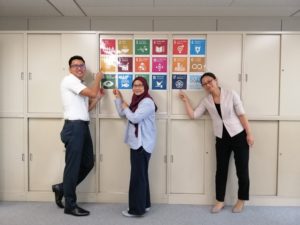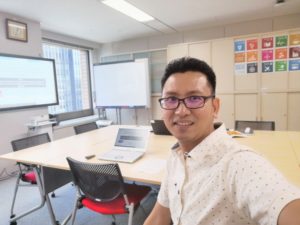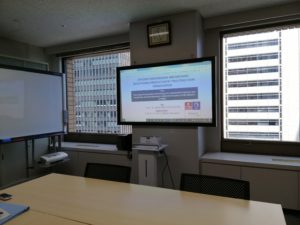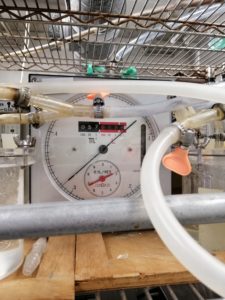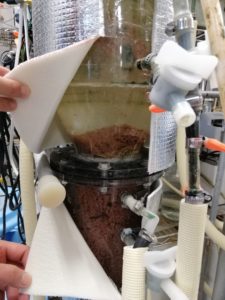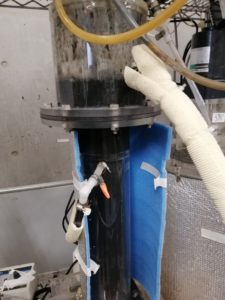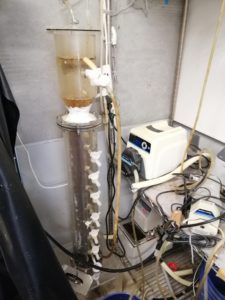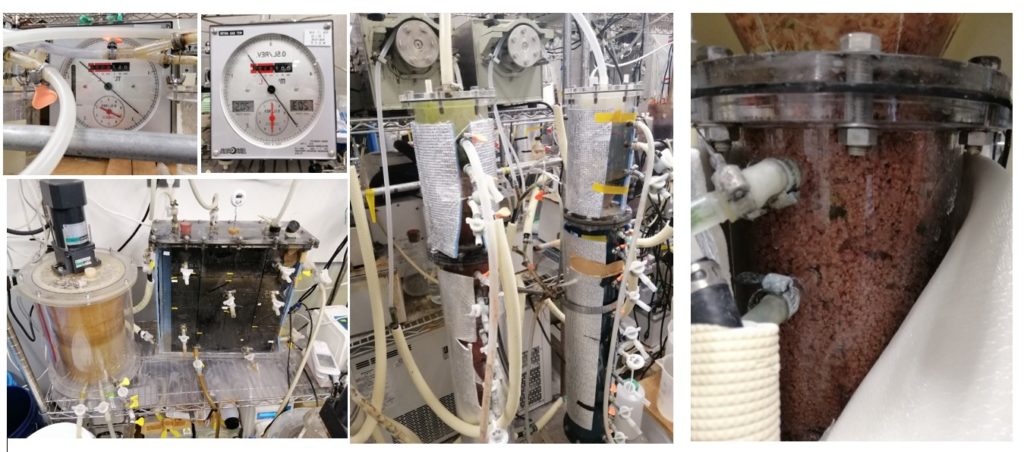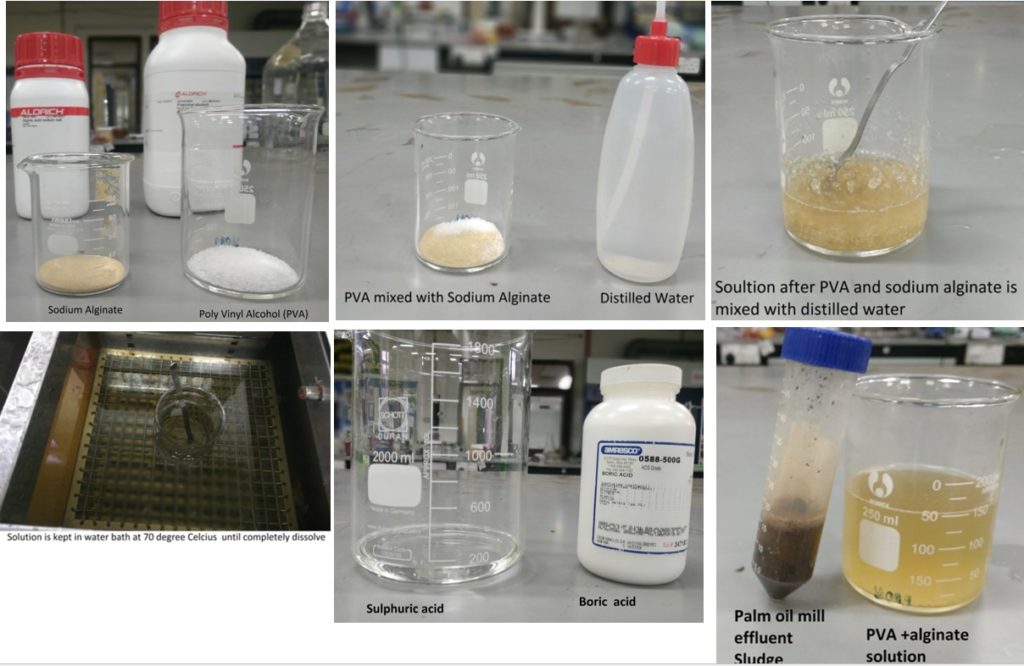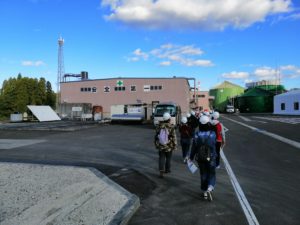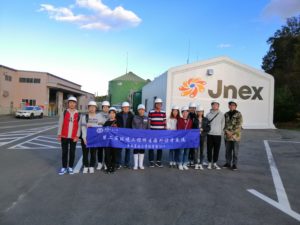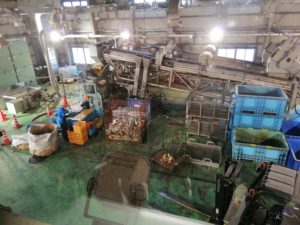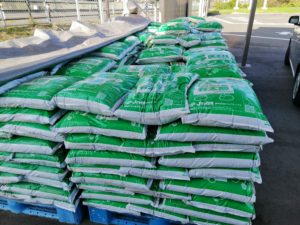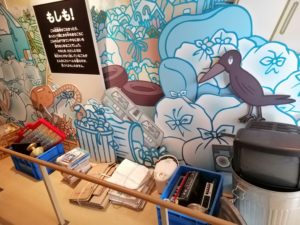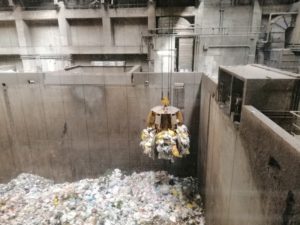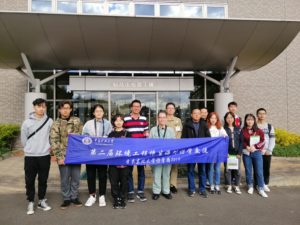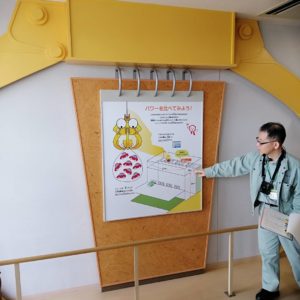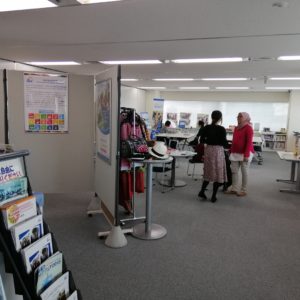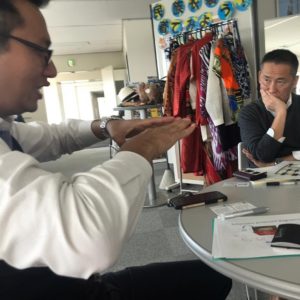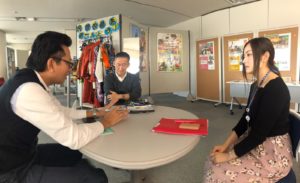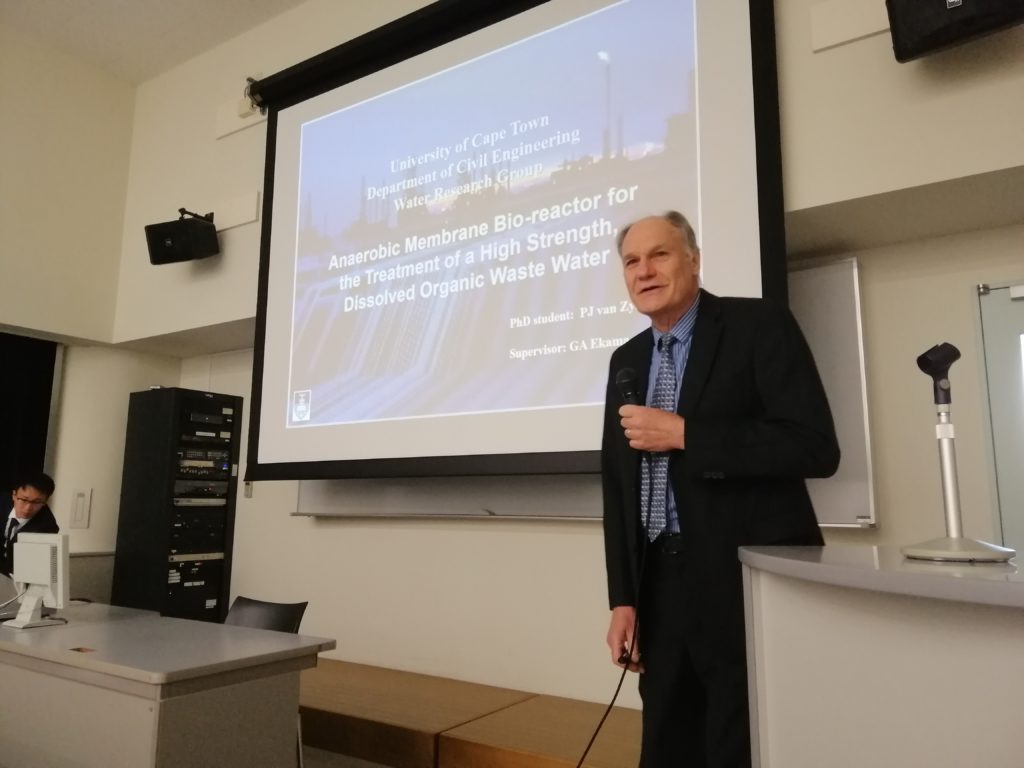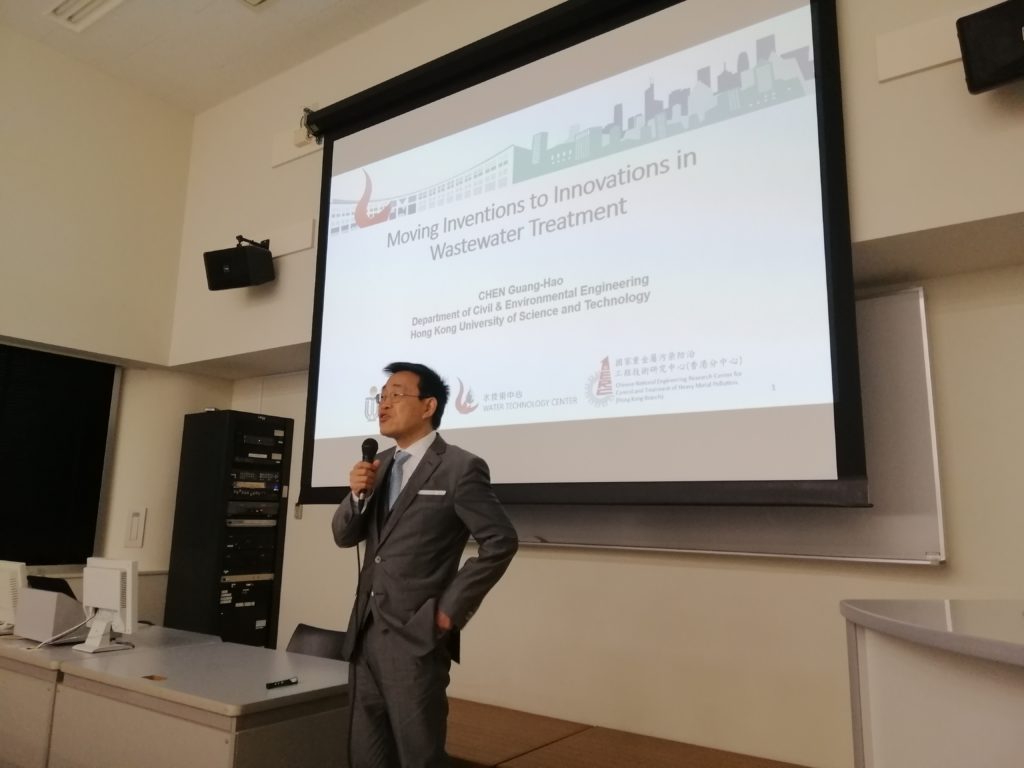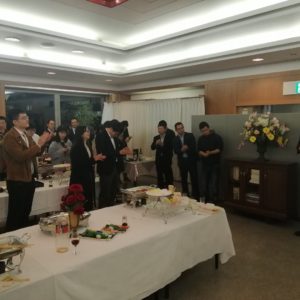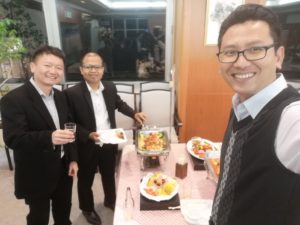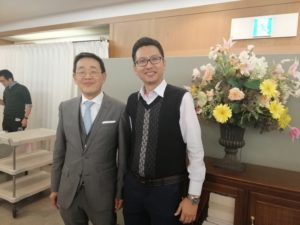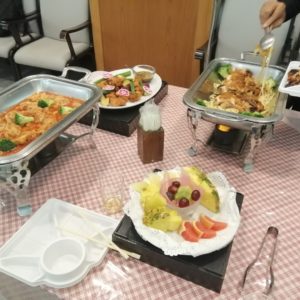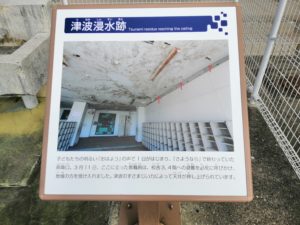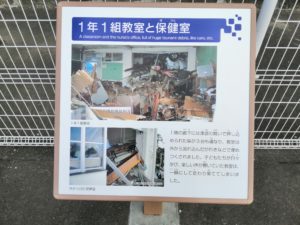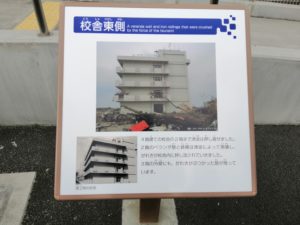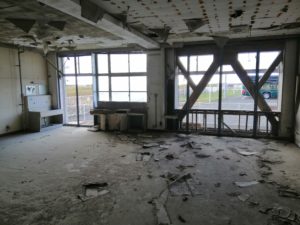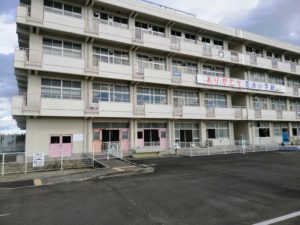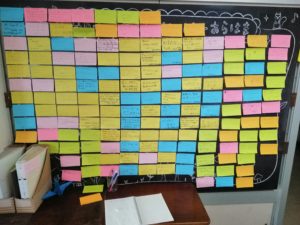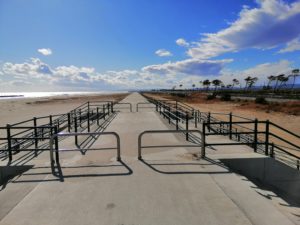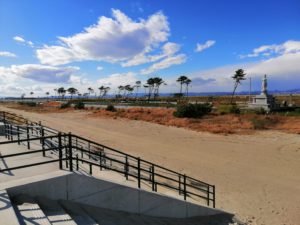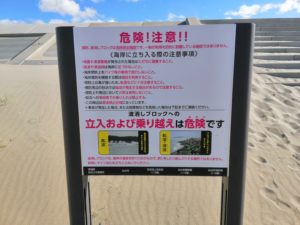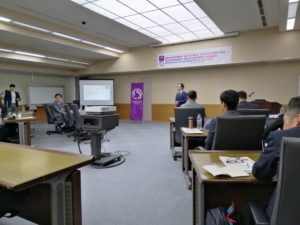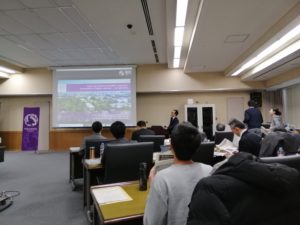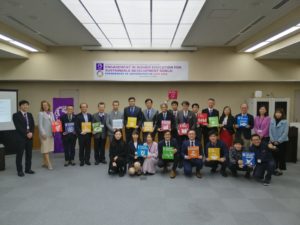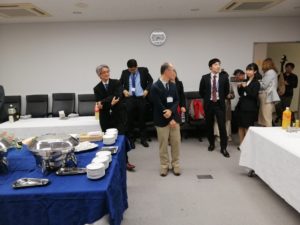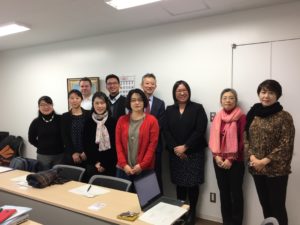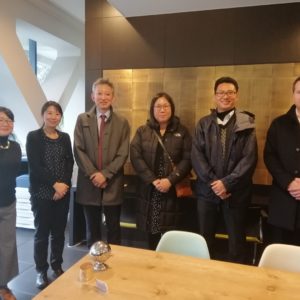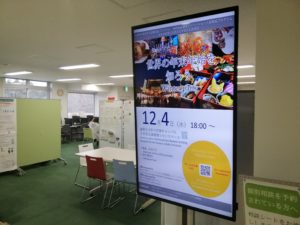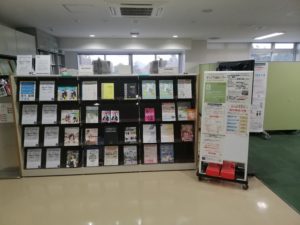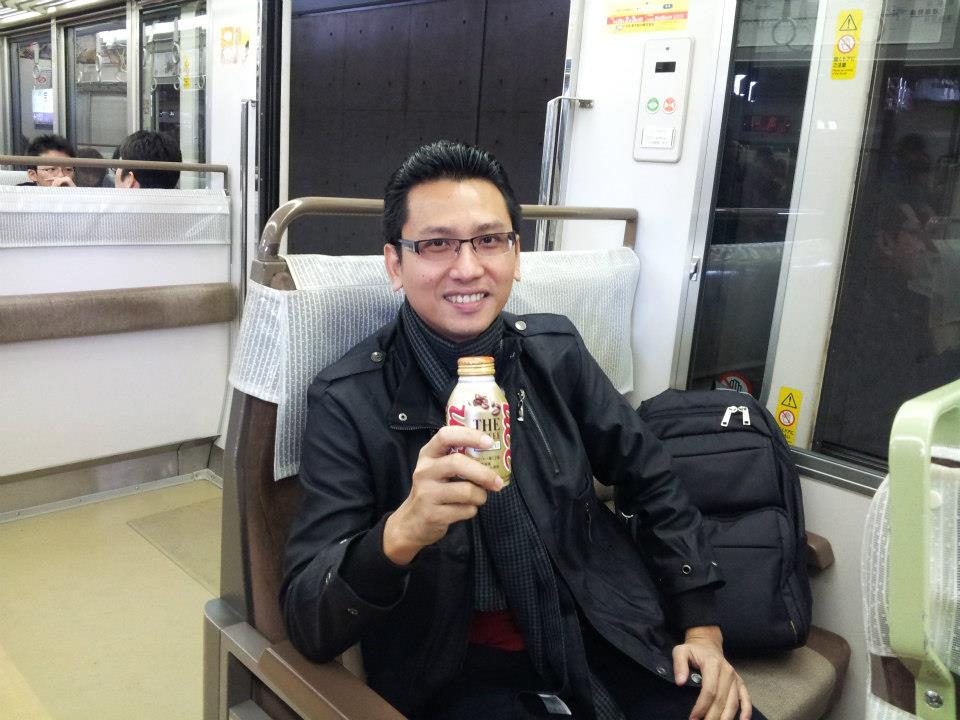Project SUMMARY and Related Activity (1st October 2019 – 31st March 2020)
The project is facilitating THREE (3) phases of short term study, including; technical overview compromising on the biohythane (hydrogen and methane) works, community translational knowledge and capacity building method. These THREE stages occupy the necessary action-plan in Renewable Energy Roadmap empowerment through self-assessment of active participation from the selected stakeholders. Usually, the biohythane is easily generated from organic wastes (e.g. food waste, soy processing wastes, etc). However, since a few years back, Palm Oil Mill Effluent (POME) is also reported promising substrates due to their higher carbon sources and the nature of thermo-substrate that suitable for higher hydrogen production rates. However, there are few limitations for the consideration in the pilot-scale and the study is evaluated TWO crucial factors, which are, (i) Encapsulation Sludge Study, and (ii) Optimization of Operational Factors from Lab-Scale. This study is also evaluating the comprehensive scale-up of Waste Treatment in Miyagi Prefecture, as the municipal transformation from Waste-to-Energy framework to compare with the next project in Malaysia. There are few case studies highlighted in this report and that could be useful in future technology-transfer in the host country. The technical visit and some overview were explained in the next activity. As the first phase concerned, the considerable process in the 6-month study, recorded high COD removal up to 94%, high gas yield (0.5 kg H2/kg COD.day and 1.2 kg CH4/kg COD.day), and recovery of the gaseous up to 84% per COD removed. However, since the 6-month training is too short for removal rate and potential biogas optimization, a simulated mathematical equation via the Response Surface Method (RSM) was developed. In the second phase, module training and community living laboratory, with a similar Renewable Energy Roadmap was established in the mainframe of New Strategic Energy in Malaysia. The outcome of the project is in line with the Malaysian energy policy; Oil, Gas, and Energy – EPP 10: Building up renewable energy & solar power capacity. By the year 2020, renewable energy is expected to contribute to a minimum of 220 megawatts, as per the target under the National Renewable Energy Policy target. Malaysian Government aims to achieve the installation of biogas facilities in all palm oil mills in Malaysia by 2020, and this could be the most influential to the development.
The Hitachi Global Foundation (HGF) as the pioneer in the translational application program recommends various platforms of the global reputation and research connectivity in the proposed study. This project is designed especially for “Energy, Environment” that could translate the technical findings into society, that the most appropriate model for Sustainable Development Goals, (SDGs). The major contribution to the project development is towards the implementation of SDGs in some of the indicator/element which elaborated in the official documentation to HGF. The effort of SDGs has been introduced in 2015, which is the United Nations adopted the 2030 Agenda for Sustainable Development that replace the previous work on Millenium Development Goals (MDGs) after Paris Agreement, including the calls for strengthening the means of implementation for development, such as finance, technology, and capacity building. It also calls for the revitalization of the global partnership for sustainable development. Therefore, this study also emphasizes on building the co-supporting activity/program that may engage in major types of co-creation with a wide range of partners in Japan and abroad, including emerging donors, to generate the maximum impact of its programs and projects and thus contribute to the attainment of the SDGs. All information and related works from September 2019 till March 2020 are posted in the next line:
Major Contribution from the Project:
- Reactor Modification and Experimental Condition
- Encapsulation Sludge (Preliminary Test)
Activity and Program
Technical Visit to Japan New Energy Expansion (JNEX): Fork-to-Energy-Farm Concept
Date: 5 November 2019
Briefing Information:
Some important message: The company name was changed from Shinsei Co., Ltd. to Janex Co., Ltd. on August 8, 2015. 80-2 Aimetsu, Izumi-ku, Sendai City. The company has a mission, ZERO WASTE, which all the incoming waste (especially the food waste) is recycled and turns up into biomaterial and bioenergy such as compost, electricity, and gas by the treatment facility “JNEX Bio plant” and returned to society, so that part of the zero-emissions can be achieved.
Technical Overview:
The methane gas was generated during the recycling process, as the pre-requisite as fuel to generate electricity, which first for the internal users and the surplus is supplied to the outside. It’s about 45% of energy is consistently generated from food waste fermentation. Amazingly, these food wastes come from regulated cafes and restaurants which have a partnership with the company. At the same time, the compost is sold to nearby farmers to grow more potential organic vegetables and realize closed-loop recycling. Unlike ordinary thermal power generation that burns fossil fuels, methanation and carbon dioxide generated from the facilities will be recycled within the closed-loop process to the environment.
The system of operation has a pre-treatment facility to ensure no contamination. In the pre-treatment building, unfit items such as wrapping paper are removed from the received food waste, and it is crushed and homogenized to ensure it could be suitable for the organic treatment processes. In the dehydration processing building, the received sludge and digested liquid after methane fermentation is dehydrated with a machine. The solid matter after dehydration is composted, and the separated liquid is further drained and released into public sewage.
Biomass material is generated in the pre-treatment building and further transfer into four fermenters (at the normal operation will assess the lignin concentration). The fermenter is always heated to reach 35 ℃, as the expecting biogas (methane gas) is produced by microbial fermentation (methane fermentation) for about 30 days. Biogas is stored in the gas holder at the top of the fermenter, and once the impurities are removed, it is used for power generation and fermenter heating. The residue (digested liquid) after methane fermentation is stored in the digestive liquid tank and send back to the dehydration processing building for internal usage.
The biogas generated is converted into electricity and heat by the co-generation system. It has a power generation capacity of more than 1,500 ordinary households. Electricity is used at this plant and surplus electricity is sold to the outside. In addition, hot water is generated by the heat generated at the same time and used to heat the fermenter.
At the end of the close-loop system, the residual of biomaterial (fertilizer components) will be formed and treated as necessary. The process consists of three buildings; a flat fermenter, a circular mechanical fermenter, and a workshop. The solid content of dewatered sludge and digestive juice is subjected to aerobic fermentation for about 10 days in a flat fermentation tank (deposition) and about 20 days in a circular mechanical fermentation tank (stirring), and then composted. The organic fertilizer “Aritaro” produced here has an excellent balance of nitrogen, phosphate, and potassium, and can be expected to have a high fertilizing effect. Safety is also checked by a testing institution, prior to being packed in the organic-farm bags for farmers
Technical Visit of the Realization of Resource Recycling Society
Date: 5 November 2019
Type: Incineration Plant from Municipal Waste
Name of Plant: Matsumori Incineration Plant
Area: Tohoku, Miyagi
Kind of Fuel: 207,000 tonnes per year of Municipal Solid Waste (MSW)
Processing Capacity: 600 tons/day
Incineration type: Fully continuous-combustion
Flue gas criteria: all performed as required by Environmental Quality Standards in Japan – Air Quality
Owner: Sendai Matsumori Clean Center
Shareholders: City of Sendai
Activity since: 2005
Information regarding initiative/activity/program related to public and society is posted on the website: http://www.city.sendai.jp/
One of the unique and interesting topics discussed during the Super Typhoon until now is about GARBAGE! They have several promotional items including “Wake Up! Sendai” for waste reduction among the citizen and foreigners. What an amazing campaign as the generated waste was increased by 0.49% higher (than last year’s performance) for about 73 tons! They also proposed for “bring it yourself” to Incinerator Plant for garden trees or any types of pruning from homes, including grasses in order to fuel-up for energy! Spiral branches that have been incinerated until now are turned into chips, which are reborn as materials for boiler fuel in plants and materials that cover garden soil to prevent drying and weeds. This will reduce the amount of garbage burned and suppress the generation of carbon dioxide. What an amazing promotion to society! This another commitment and everybody could participate for those who wanted to experience the same Recycling Society Environment. What a wonderful program created by the division
Another promotion is The “Clean Sendai Promotion System” entrusts people recommended by neighborhood associations to “Clean Sendai Promotion Team” and “Clean Mate” and conducts activities such as proper waste disposal, weight reduction and recycling in each region. It is a system that aims to effectively promote the creation of a comfortable living environment in collaboration with citizens and the government by taking the role of a leader. (Introduced in August 1995). They have some volunteer program which also covers for inspection garbage, survey for waste reduction, illegal dumping patrol activity and many more. This is such a lovely credit to the municipality to ensure all society aware and having practical at their home.
This facility having the latest pollution-prevention technologies (using oxygen-enriched combustion) to operate the system with consideration of air-emission pollutants (provides de-NOx catalytic equipment) and latest flue gas treatment system. In conjunction with effective waste heat utilization, the technology for steaming produces around 17,500 kW of electricity, which could supply the facility itself and sell offsite. For example, the waste heat generated from the plant is also used to heat water for supply to an adjacent facility open to the general public. Furthermore, the facility is provided with an electric ash melting system to reduce the volume of generated bottom ash and fly ash. This ash is melted and then solidified to facilitate effective utilization.
JICA Tohoku Session & Networking on SDGs
Date: 12 November 2019
Officer(s):
- MIMURA Satoru (Deputy Director-General, Senior Director, Global Environment Department, Executive Senior Research Fellow, JICA Research Institute)
- ISAWA Hitomi (Program Officer, Administration Division, Training Program, Public Relation)
Topics of Discussion:
- Zero Waste Society and Community Empowerment via various scholar, institutions and region around the globe by JICA
The specific agenda on waste was discussed almost two decades by JICA in organizing and empowering the most affected area in the world. There are few considerations for the summary in tackling the waste scenario, with a variety of focus group discussion (FGD), improper service and management, disposal site and its treatment, and stakeholders’ engagement. As the most serious issue on the outbreak of diseases, the creating of the waste mountain creates a risk issue especially fire-burning and contamination to the water resources.
- Initiative in Higashimatsushima City regarding the recycling initiative of disaster waste management. A case study is important for replication in developing countries or low-income community
Roundtable discussion in observing the input/outcome from Higashimatsushima City – Recovery from the Disaster. This city becomes the selected model cities in the “FutureCity” Initiative to establish a sustainable society, capable of managing the socio-economic issues, rapid aging, and disaster preparedness. The discussion and further several frameworks were established as to build-up the Higashimatsuhima Method in the process of rebuilding efforts from the Great East Japan Earthquake. Experts from many sectors have been collaboratively established with an organization, named as Higashimatsushima Organization for Progress and Economy, Education, Energy (HOPE), for the empowerment effort towards sustainable local development.
- Okinawa University, Case Study in implementing Waste Management
- Marine litter and microplastic voluntary program around JICA works
- Biomass-to-Energy in selected communities level.
- Campuses Initiatives movement towards Sustainable Development Goals: Waste, Energy, and Climate
The 7th International Symposium on Water Environment Systems – with Perspective of Global Safety
Date: November 14th – 16th, 2019
Venue: Room 110, Engineering Laboratory Complex Building, Department of Civil and Environment Engineering, Graduate School of Engineering, Tohoku University
This international symposium is an annual program under the Graduate School of Environmental Studies to accelerate the official networking among other faculties, schools, and regions, especially the partners and collaborators. Usually, the program will assembly all postgraduate members to present the recent update of the study and working as cross-checking networking with new researchers in the field. A special trip and technical visit will arrange by the committee, with the relevant content and prototype plant. In this session, a commercial project of Sewage and Energy between Tohoku University and Mitsubishi Co. is being selected as the technical visit.
Sponsors: http://gp-rss.tohoku.ac.jp/en/index.html and https://www.eng.tohoku.ac.jp/
Agenda and Content of the Symposium
- Special Keynote Address by Prof George A. EKAMA (University of Cape Town) –Anaerobic treatment of a low pH high strength dissolved organic wastewater in a membrane bioreactor
- Special Keynote Address by Prof Guang-Hao CHEN (The Hong Kong University of Science and Technology) – Moving inventions to innovations in wastewater and sludge treatment
- Seminars by Participants
- (Section Water, Wastewater and Waste Management (Section II, III, IV)
- Global Climate Assessment (Section V)
- Poster Exhibition
- Dinner / Closing Remarks
Technical Visit to Arahama’s Elementary School – Tsunami Impacted Zone
Date: 15th November 2019
The technical visit was organized with the 7th International Symposium on Water Environment Systems, led by Assist. Prof. Dr. Y. Touge. Special visit to this Elementary School and further explore the historical evident during the Tsunami struck in the area. In the website, the information is quoted, as below:
Ruins of the Great East Earthquake: Sendai Arahama Elementary School
“Directly after the earthquake struck, the four-story reinforced concrete school building became the evacuation area for 320 residents, students, and school personnel. The tsunami surged up to the 2nd floor, and everyone who had evacuated to the school building managed to escape safely to the rooftop. It is our city’s goal to never again fall victim to a tsunami, to pass on the lessons we learned also and to show the real threat of a tsunami to future generations. For these reasons, the ruins of the Arahama Elementary School building will be preserved, along with other records, and opened to the public.”
[link: https://sendairesilience.jp/en/efforts/government/information/preservation.html]
Authority: Disaster-Resilient and Environmentally-Friendly City Promotion Office, City Planning Policy Bureau
Sendai City, as the pioneered initiatives since 20111 aims to keep the memories of the disaster through the establishment of a memorial center and the archiving of videos and photographs in collaboration with residents and several community groups. This is a reflection from the Sendai Framework as being adapted at the Third UN World Conference on Disaster Risk Reduction, for the communities sharing on the experiences and lessons learned from the disaster, thus contributing to disaster prevention and disaster risk reduction in the world. The most comprehensive framework, roadmap, capacity building and lesson-learned can be viewed from [link: https://sendai-resilience.jp/en/]
Coastal Embankment Development
Based on the experienced Tsunami struck in 2011, the Miyagi Prefectural government constructed massive planning on geotextile structure alongside Arahama, Gamo and Ido and Fujitsuka areas.
“To firstly prepare for a tsunami that may occur frequently (once every several decades to once every hundred years or more), we are constructing a coastal embankment of around 9 km in length and a height of T. P. plus 7.2 m, jointly with the central government and Miyagi Prefectural government. The embankment is designed so that, even in the event of a tsunami that exceeds our expectations, its breakdown or collapse time can be extended or the possibility of its total collapse is reduced. Completion is scheduled for FY 2016”
[link: https://sendai-resilience.jp/en/efforts/government/development/coastal_embankment.html]
INTERNATIONAL SYMPOSIUM ON ENGAGEMENT IN HIGHER EDUCATION FOR SUSTAINABLE DEVELOPMENT GOALS: EXPERIENCES OF UNIVERSITIES IN EAST ASIA
Date: 23rd November 2019
Host: Graduate School of Education, Tohoku University Sendai, Japan
Venue: 11th Meeting Hall, Graduate School of Education, Tohoku University Sendai, Japan
Agenda and Key Messages:
- Education 2030 Framework for Action (UNESCO, 2015) (website: http://uis.unesco.org/sites/default/files/documents/education-2030-incheon-framework-for-action-implementation-of-sdg4-2016-en_2.pdf)
- Education for Sustainable Development (ESD) in 2030 (website: https://en.unesco.org/esdfor2030) – Prof. Dr. Zhu Zhiyong
- SDGs and Global Leader Education (Tohoku University Global Leader Program) (website: https://www.tohoku.ac.jp/en/news/university_news/tu_glp_award_2017_18.html) – Dr Yuki Watanabe
- Global Environmental Leaders Program (GELP) (http://www.civil.nagoya-u.ac.jp/nugelp/index.html)
- Global Environment Program (GEP) (https://www.tsinghua.edu.cn/publish/enven/9196/9196/gjb_en.pdf) and (https://www.tsinghua.edu.cn/publish/enven/8906/index.html) – Assoc Prof. Dr Xi Lu
- Teaching and Research on Design for Sustainability (LeNS) – the Learning Network on Sustainability (http://www.lens-international.org/about) – Prof Liu Xin
- Strategies & Commitment of SDGs (Case Study: Tohoku University):
- Tohoku University Vision 2030 (Strategic Advancement and Cross-Sectoral Globalization on Campus)
- Process 1 (Advancement of International Collaboration) and Process 2 (Comprehensive Internalization)
- General Education for Future Leaders
- Global Governance and Sustainable Development Program – G2SD Program
- Disaster Recovery to the Tohoku University and SDGs
- Research: Impact to Society and SDGs
- Core Research Cluster and World Leading Research Centres
- Promotional and Activity
- Seminar for Educational Leaders in Tohoku University (SELTU) – developing knowledge, opportunity in professional learning community. Joining based on the recommendation of local education authorities from Elementary, Junior High and High-Special Need School)
- Green Development Campus – SNU Institute for Sustainable Development (ISD) – Seoul National University, South Korea (http://aiees.snu.ac.kr/neo/main_eng) – Prof Dr Sung-Sang Yoo
Official Meeting and Discussion on “International and Global Higher Education Institutions (HEIs) Framework in Regional Network”
Date: 2 December 2019
Venue: Block 3, Global Learning Centre, Kawauchi Campus Tohoku University
Time: 10am – 2 pm
Agenda:
- Welcoming Address by Vice Director of International Strategy Office, Tohoku University (Prof Dr Akiyoshi Yonezawa)
- A brainstorming session with Global Learning Centre, Institute for Excellence in Higher Education (IEHE)
- Presentation by Assistant Professor, Dr. Meng-Hsuan Chou (NTU, Singapore) entitled “Comparative Regionalism and Higher Education Research”
- Higher Education regionalism and implication
- Promoting intra- and inter-regionalism
- Examples of HE regionalism within the EU, Africa, Asia, and Latin America
- Comparative HE regionalism research
- Heuristic Framework for the inter-regional dynamic in HE
- Case Study in EU and South-East Asia
- Institutionalism of Bologna Process
- Rise of the ASEAN HE space
- Reflection in Methodological and Epistemological
- Short Tour, Kawauchi Campus Facility
- Lunch and Networking Session
- Progress Meeting
